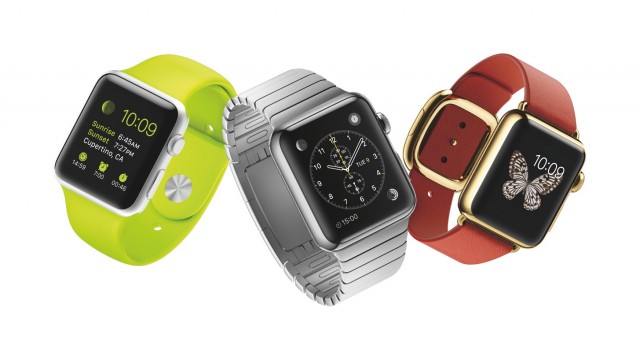Apple Watch could be the first in a new wave of wearable technology for musicians.
The idea isn’t new. We’ve seen various notions involving wearing extra controls for music. In fact, the whole category of alternative interfaces is deeply indebted to Michael Waisvisz, who helmed STEIM for many years and whose interface The Hands inspired generations of musical gloves and gestural interfaces. Guitarists have had various rings to wear; IK Multimedia is currently experimenting with rings that aid in gestural control of iOS.
Apple Watch may not become the accessory the iPad and iPhone have for music, but – partly due to the success of those platforms – it’s ripe for experimentation. And since I can already prepare Traktor sets with my iPhone and plug my guitar through an iPad, music companies already target iOS as an additional platform (atop Windows and Mac).
Those developers should see Apple Watch alongside the iPad, iPhone, and iPod touch developer tools soon. Apple is promising that you’ll be able to use their wrist-born iOS gadget for notifications and information, with “fully native” apps (presumably iOS apps with a different screen size and hardware capabilities) “later next year.” So, figure notifications first, full apps later. Even the former will be useful, but putting those two categories together, imagine this:
Visual notifications while you play. BPM, cues in songs, uh… lyrics, if you’re especially bad at remembering them.
Remote controls. Transport controls and the like are a logical app. Think of a simple app with wireless Mackie Control for transport information.
Touch. The iPad and even iPhone offer larger touch surfaces, but you do get something out of the Watch. There’s reportedly pressure sensitivity, and “Taptic” provides haptic feedback. Now, you wouldn’t buy an Apple Watch for these features, but you can bet some developers will try hacking creative musical applications with them anyway. The new touch sensing tech could be something we see on iOS devices later, too.
Easy-access controls. Even the “Digital Crown” looks useful. Imagine a metronome on your wrist, turning this dial to change the tempo up and down precisely.
Wireless and Bluetooth provide a connection with your computer, so as with iPhone and iPad controllers, remote control is a likely application.
But I could see a KORG tuner or metronome on the Apple Watch, too, or an Ableton transport.
Copy and paste the above observations to Android-powered watches, or other wearable tech, too, of course, but there’s reason to wait for Apple to run this headline. I think the Apple Watch has a particular shot in that so far Android watches have been fairly disappointing in their design, and that iOS, unlike Android, has proven a viable platform for music developers to actually make money, reach customers, and find a single platform that’s easy to develop for and test. Even at companies that are giants of music tech, there simply aren’t big budgets for testing on a lot of different devices, and so critical mass has very logically shifted to iOS. (A reader called this a “monoculture” last week. Hardly – AAX, VST, AU, OS X, Windows, Linux, 32-bit and 64-bit and different OSes on top of embedded and DSP chips… this industry has enough platforms, so one mobile OS may be enough.)
Apple Watch is mostly a teaser at this point. We should know more as Watch Kit shows up in the developer tools. Apple’s increasingly liberal policy on developer NDAs should also mean we get to talk about it sooner.
Now, I’m very skeptical as I’m sure you are about whether I personally need such a thing – that’s $350 that could be spent on an entire synthesizer, which is more fun than a watch. (I like watches, the old-fashioned kind.) But I bring this up in part because I imagine the Apple Watch could serve as a platform for new ideas. It’s possible (and often desirable) to prototype synth hardware on the iPad. And the very presence of the Apple Watch on the market may reinvigorate a decades-old discussion about just what sorts of sensors and instruments you would want to wear. (McRorie, again, ahead of his time – the musical utilikilt may always beat the watch.)
And because many DIY solutions can be constructed for far less than $350, there’s no reason you can’t go off and make your own, non-Apple wrist-worn creation today. That’ll fill the time.
But whether it’s made by Apple or not, I’m fairly confident that the cultural impact of Apple’s creation is that wrists will go naked no more.
http://www.apple.com/watch/technology/
